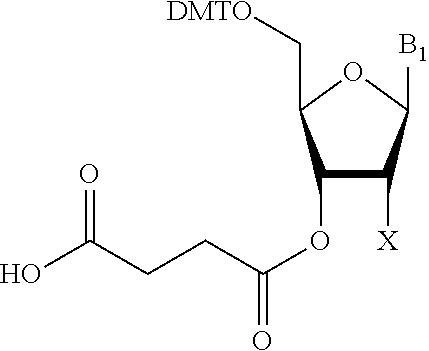Solid-phase support for oligonucleotide synthesis and oligonucleotide synthesis method
a technology of oligonucleotide and solid-phase support, which is applied in the direction of organic chemistry, sugar derivatives, chemistry apparatus and processes, etc., can solve the problems of low synthesizability (synthetic purity and synthetic quantity), and the problem of problematically increasing the synthesizability lower than expected, so as to achieve high synthesizability and high synthetic quantity , the effect of low loading amoun
- Summary
- Abstract
- Description
- Claims
- Application Information
AI Technical Summary
Benefits of technology
Problems solved by technology
Method used
Image
Examples
example 1
Production of Porous Resin Beads
[0088]A 500 ml separable flask equipped with a condenser, an agitator and a nitrogen introducing tube was set on a constant temperature water bath and polyvinyl alcohol (2.6 g, manufactured by KURARAY) and distilled water (260 g) were charged therein and stirred at 300 rpm to dissolve the polyvinyl alcohol. Styrene (23.7 g, manufactured by Wako Pure Chemical Industries, Ltd.), p-acetoxystyrene (3.2 g, manufactured by Aldrich), divinylbenzene (21.5 g, content 55%, manufactured by Wako Pure Chemical Industries, Ltd.), polyethylene glycol methyl ether methacrylate (5.4 g, manufactured by Sigma-Aldrich, average Mn 300), 2-ethylhexanol (60.3 g, manufactured by Wako Pure Chemical Industries, Ltd.), isooctane (25.9 g, manufactured by Wako Pure Chemical Industries, Ltd.) and benzoyl peroxide (1.1 g, 25% in water, manufactured by NOF corporation) were mixed and dissolved, and the solution was added thereto. The mixture was stirred (50 rpm) at room temperature ...
example 2
[0098]In the same manner as in Example 1 except that the composition of Table 1 (Example 2) was used, DMT-dT-3′-succinate was loaded on the porous resin beads obtained in Example 1. The amount of DMT-dT-3′-succinate loaded on the obtained porous resin beads was 45 μmol / g.
[0099]The porous resin beads loaded DMT-dT-3′-succinate obtained above were filled in a synthesis column to a synthesis scale of 1 μmol, set on an ABI3400 DNA / RNA synthesizer (manufactured by Applied Biosystems), and DNA oligonucleotides with a 40 mer mixed sequence were synthesized under the conditions of nucleoside phosphoramidite concentration of 0.1 M and DMT-on. The column after synthesis was dried, DNA oligonucleotides were cleaved out from the porous resin beads and the base amino group was deprotected. The porous resin beads were separated by filter filtration and, from UV absorbance measurement (260 nm) of the filtrate, an OD yield of the DNA oligonucleotides (corresponding to DNA oligonucleotides synthetic...
example 3
[0106]In the same manner as in Example 1 except that styrene (46.9 g, manufactured by Wako Pure Chemical Industries, Ltd.), p-acetoxystyrene (3.7 g, manufactured by Aldrich), divinylbenzene (7.3 g, content 55%, manufactured by Wako Pure Chemical Industries, Ltd.), polyethylene glycol methyl ether methacrylate (3.0 g, manufactured by Sigma-Aldrich, average Mn 950), 2-ethylhexanol (55.4 g, manufactured by Wako Pure Chemical Industries, Ltd.), isooctane (23.7 g, manufactured by Wako Pure Chemical Industries, Ltd.) and benzoyl peroxide (1.2 g, 25% in water, manufactured by NOF corporation) were used as the composition for polymerization, porous resin beads comprised of a styrene-divinylbenzene-p-hydroxystyrene-polyethylene glycol methyl ether methacrylate copolymer were obtained.
[0107]In the same manner as in Example 1 except that the composition of Table 1 (Example 3) was used, DMT-dT-3′-succinate was loaded on the obtained porous resin beads. The amount of DMT-dT-3′-succinate loaded o...
PUM
| Property | Measurement | Unit |
|---|---|---|
| mercury surface tension | aaaaa | aaaaa |
| mercury contact angle | aaaaa | aaaaa |
| temperature | aaaaa | aaaaa |
Abstract
Description
Claims
Application Information
 Login to View More
Login to View More - R&D
- Intellectual Property
- Life Sciences
- Materials
- Tech Scout
- Unparalleled Data Quality
- Higher Quality Content
- 60% Fewer Hallucinations
Browse by: Latest US Patents, China's latest patents, Technical Efficacy Thesaurus, Application Domain, Technology Topic, Popular Technical Reports.
© 2025 PatSnap. All rights reserved.Legal|Privacy policy|Modern Slavery Act Transparency Statement|Sitemap|About US| Contact US: help@patsnap.com

